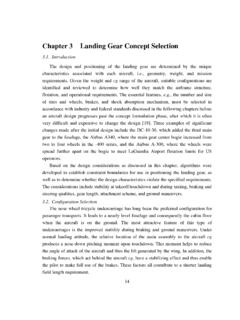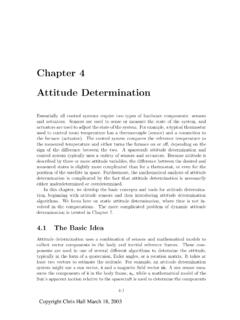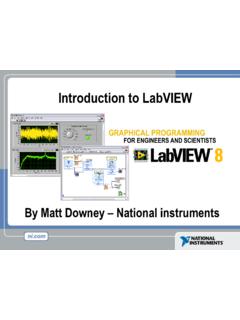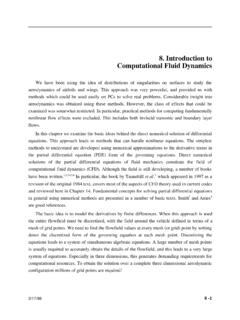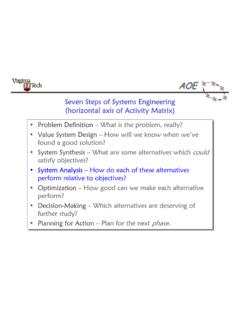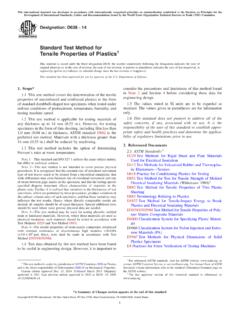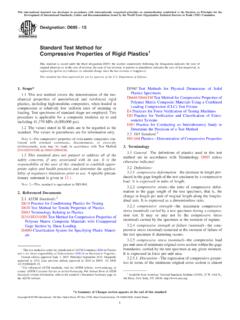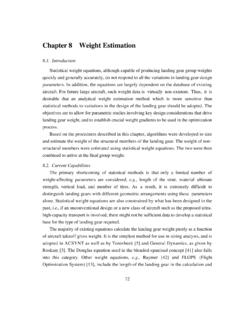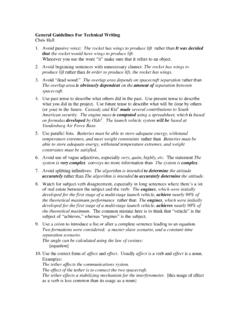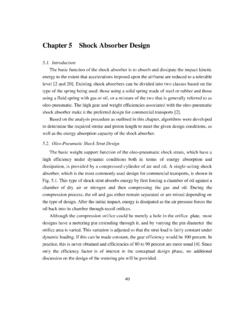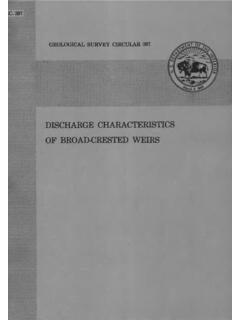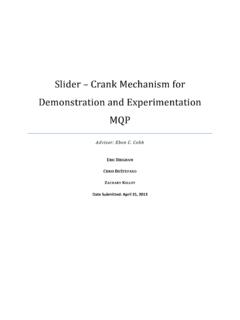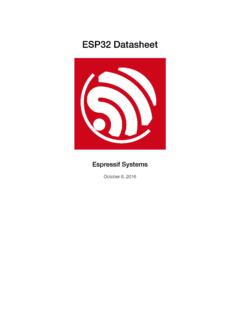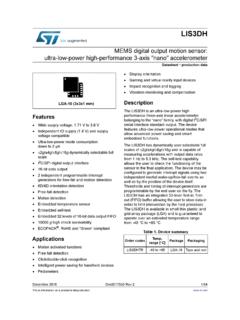Transcription of General Dynamics F-16 Fighting Falcon
1 4/21/041 DynamicsF-16 Fighting FalconAdam EntsmingerDavid GallagherWill GrafAOE 41244/21/042 Outline Purpose/Mission Aerodynamic Configuration Lift Drag Planform Issues and Analysis Airfoil Issues and Analysis Trim Trim Drag Performance Pros/Cons F-16 Experimental Variants4/21/043 Purpose/Mission RFP (issued Jan. 16, 1971) Provide an aircraft with maximum usable maneuverability andeffectiveness in both the air-to-air and air-to-ground combat arenasbut within the constraints of minimizing the cost and complexity Superior maneuver performance and handling qualities at subsonic andtransonic speeds ( <M< ) Superior acceleration The carriage of a variety of the latest air-to-ground weapons and theiraccurate delivery A subsonic-cruise lift-to-drag ratio sufficient to provide effective missionradii with a variety of payloads High T/W ratio TOGW < 20.
2 000lbs Operate at altitudes between 30 and 40 thousand feet4/21/044 Aerodynamic Configuration Leading Edge Extensions Provide controlled vortex lift Produces lift on the inboard portion of the wing and straightens the flow over theoutboard portion of the wing Strake geometry and its interface with the forebody and wing weredeveloped over many hours of wind tunnel testing of more than 50configurations Net increase in lift at high angles of attack is over 25 percent Reduces buffet intensity Improves directional stability Increases trimmed lift-to-drag ratio Tail Chose single tail over twin Less buffeting from strake vortices at high alpha Engine Intake Located below the nose a Avoids gun gas ingestion and landing FOD4/21/045 Aerodynamic Configuration Automatic Variable Camber Provides an aerodynamically efficient wing surface throughout the flightenvelope LE flap is automatically positioned to minimize drag and buffet at all flightconditions Optimizes the wing camber for turning maneuvers, cruise, and acceleration At M > 1.
3 LE and TE flaps are fixed at -2 degrees Reduces profile drag at low angles of attack Improves acceleration characteristics Improves directional stability at high lift coefficients Increases sustained and instantaneous lift up to 12 percent Reduces buffet intensity by almost 60 percent4/21/046 Aerodynamic Configuration Relaxed Static Stability Increases lift-to-drag ratios at subsonic and supersonic speeds Reduces down-load on the horizontal tail required to trim at high liftcoefficients and at supersonic speeds Increases total lift available at sustained-turn conditions (2% at subsonic cruise,4-8% at M = , and 8-15% at M = ) Blended Wing/Body Provides additional volume for fuel storage, increasing range Reduces wetted surface area, reducing drag Increases structure rigidity Supersonic Area Ruling Decreases wave-drag Particular attention was given to the bubble canopy in the final area rulingof the fuselage/strake/nacelle combination4/21/047 LiftCLmax , Luat T.
4 Simulator Study of Stall/Post-Stall characteristics of aFighter Airplane With Relaxed Longitudinal Static Stability. NASA TechnicalPaper 1538. Dec. , , Kent, , Webb, Correlation of F-16 aerodynamics and performance predictions withearly flight test results. Agard Conference Proceedings. n 242. Oct 11-13, Issues and Analysis Span e e at CL = Vortex Lattice Method alpha(per deg) alpha(per deg) Wind Tunnel(M= )VLMpc(M= )Tornado(M= )4/21/0410 Airfoil Issues and Analysis Airfoil NACA 64A204 Variable CamberSpick, Mike, ed. The Great Book of Modern Warplanes. SalamanderBooks Ltd: London, UK, , Luat T. Simulator Study of Stall/Post-Stall characteristics of aFighter Airplane With Relaxed Longitudinal Static Stability. NASA TechnicalPaper 1538. Dec. DragDroste, Carl S.
5 , Walker, James E. The General Dynamics Case Study on the F-16 Fly-By-Wire Flight Control System. AIAA ProfessionalStudy Empty Weight 16,285 lb Combat Takeoff 26,536 lb Maximum Takeoff Weight 37,500 lb Wing Loading 88 lb/ft2 Maximum Thrust 23,830 lb (27, 000 lb for later models) Thrust/Weight Ratio Maximum Velocity Mach (+) Ceiling 50,000 ft Climb Rate 50,000 ft/min Maximum Range 2,425 miles Max G-rating 9g with 100% fuel ( with 80% fuel) AOA Limiter (basic, roll rate, and yaw rate) ARI Schedule (-AOA, -Mach) Rudder Authority Limiting4/21/0414 PerformanceWebb, , Kent, , Webb, Correlation of F-16 aerodynamics and performance predictions withearly flight test results. Agard Conference Proceedings. n 242. Oct 11-13, , , Kent, , Webb, Correlation of F-16 aerodynamics andperformance predictions with early flight test results.
6 Agard ConferenceProceedings. n 242. Oct 11-13, Relatively long range Lower TOGW from variousconfig. Option allows anincreased turning rate (10%)and acceleration (30%) Small size = low radar returns Bubble canopy has large rangeof vision Designed to carry moremissiles than specified Lower cost from using commoncomponents Upgradeable Increased life in airframeCons Deep stall possible at 60 degAOA Fixed engine inlet geometryreduces TOGW, but limits M<2 OEI is a problem with only oneengine Possible problem with controlsystem (fly-by-wire) whenstruck by lightning4/21/0417F-16 Experimental Optimized for supercruise4/21/0418F-16 Experimental VariantsAFTI/F-16 Experimentation with decoupled flight4/21/0419 ReferencesDroste, Carl S., Walker, James E. The General Dynamics Case Study onthe F-16 Fly-By-Wire Flight Control System.
7 AIAA Professional , Luat T. Simulator Study of Stall/Post-Stall Characteristicsof a Fighter Airplane With Relaxed Longitudinal Static Stability. NASAT echnical Paper 1538. Dec. , Bill, Holder, Bill. F-16 Fighting Falcon . 3rd ed. Tab/Aero Books:Blue Ridge Summit, Pennsylvania, , Mike, ed. The Great Book of Modern Warplanes. SalamanderBooks Ltd: London, UK, , , Kent, , Webb, Correlation of F-16 aerodynamics andperformance predictions with early flight test results. AgardConference Proceedings. n 242. Oct 11-13, 19 April 2004. < >4/21/0420 Questions?
